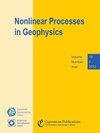集成黎曼数据同化:面向大尺度动力系统
IF 2.4
4区 地球科学
Q3 GEOSCIENCES, MULTIDISCIPLINARY
引用次数: 2
摘要
摘要本文介绍了相对高维非线性动力系统的系综黎曼数据同化的结果,重点讨论了大气环流的混沌Lorenz-96模型和两层准地转(QG)模型。该方法中的分析状态是从联合分布推断出来的,该联合分布将背景概率分布和似然函数最佳耦合,从而能够在没有任何高斯假设的情况下正式处理系统偏差。尽管在耦合分布的计算中存在维数诅咒的风险,但与粒子滤波器和随机集合卡尔曼滤波器的经典实现进行比较表明,在相同的集合大小下,所提出的方法可以提高动力系统的可预测性。特别是,在系统误差下,分析状态的均方根误差可以减少20 % (30 %) 在Lorenz-96(QG)模型中。本文章由计算机程序翻译,如有差异,请以英文原文为准。
Ensemble Riemannian data assimilation: towards large-scale dynamical systems
Abstract. This paper presents the results of the ensemble Riemannian data assimilation for relatively high-dimensional nonlinear dynamical systems, focusing on the chaotic Lorenz-96 model and a two-layer quasi-geostrophic (QG) model of atmospheric circulation. The analysis state in this approach is inferred from a joint distribution that optimally couples the background probability distribution and the likelihood function, enabling formal treatment of systematic biases without any Gaussian assumptions. Despite the risk of the curse of dimensionality in the computation of the coupling distribution, comparisons with the classic implementation of the particle filter and the stochastic ensemble Kalman filter demonstrate that, with the same ensemble size, the presented methodology could improve the predictability of dynamical systems. In particular, under systematic errors, the root mean squared error of the analysis state can be reduced by 20 % (30 %) in the Lorenz-96 (QG) model.
求助全文
通过发布文献求助,成功后即可免费获取论文全文。
去求助
来源期刊

Nonlinear Processes in Geophysics
地学-地球化学与地球物理
CiteScore
4.00
自引率
0.00%
发文量
21
审稿时长
6-12 weeks
期刊介绍:
Nonlinear Processes in Geophysics (NPG) is an international, inter-/trans-disciplinary, non-profit journal devoted to breaking the deadlocks often faced by standard approaches in Earth and space sciences. It therefore solicits disruptive and innovative concepts and methodologies, as well as original applications of these to address the ubiquitous complexity in geoscience systems, and in interacting social and biological systems. Such systems are nonlinear, with responses strongly non-proportional to perturbations, and show an associated extreme variability across scales.
 求助内容:
求助内容: 应助结果提醒方式:
应助结果提醒方式:


